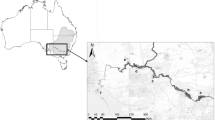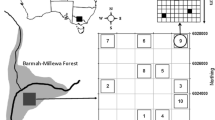Abstract
The abundance and species composition in the seed-bank and extant vegetation were investigated in a lakeshore wetland. The seed-bank in different layers at 5 cm intervals was also studied by using the seedling-emergence method with waterlogged and submerged greenhouse treatments. Thirty-four species and 1788 seedlings germinated in the seed-bank, with a mean density of 1227 seedlings m−2 (40–2600). Thirty-one species and 22261 individuals were obtained in the extant vegetation with a mean density of 1436 seedlings m−2 (368–12632). The Margalef species richness index was 4.41 in the seed-bank and 2.99 in the extant vegetation. Little overlap (14 taxa, 43%) was found between the seed-bank and the extant vegetation. The total number of species and seedlings that germinated in different layers was significantly different. The number of species that germinated in the surface layer (21 taxa) was not significantly different from that in the second layer (27 taxa). Only 39.2% of the total number of seedlings appeared in the surface layer. Our results indicated that a lakeshore wetland seed-bank with viable seeds and high species richness can be used as a macrophyte pool in degraded wetland restoration. Vegetation produced from such a seed-bank will have species similar to the pre-disturbance assemblage. The large number of viable seeds that we found conserved in deeper layers suggests that the most valuable macrophyte pools are conserved at depth. With disturbance, these seeds could be brought back to the surface, and serve as a reserve in recruiting the extant vegetation. We suggest using the sediment containing rich viable propagules in the actual reconstruction project.




Similar content being viewed by others
References
Bekker RM, Bakker JP, Grandin U et al (1998) Seed size, shape and vertical distribution in the soil: indicators of seed longevity. Funct Ecol 12:834–842
Bonis A, Lepart J (1994) Vertical structure of seed banks and the impact of depth of burial on recruitment in two temporary marshes. Plant Ecol 112:127–139
Brown SC, Bedford BL (1997) Restoration of wetland vegetation with transplanted wetland soil: an experimental study. Wetlands 17:424–437
Budelsky AR, Galatowitsch MS (2000) Effects of water regime and competition on the establishment of a native sedge in restored wetlands. J Appl Ecol 37:971–985
Chen SJ, Wang XL, Lu SH (2002) Water resource and water level control of Honghu Lake. Journal of Central China Normal University (Nat Sci ) 36:121–124
Eriksson O (1992) Evolution of seed dispersal and recruitment in clonal plants. Oikos 63:439–448
Goodson JM, Gurnell AM, Angold PG et al (2002) Riparian seed banks along the lower River Dove, UK: their structure and ecological implications. Geomorphology 47:45–60
Grelsson G, Nilson C (1991) Vegetation and seed-bank relationships on a lakeshore. Freshwat Biol 26:199–207
Harper JL (1977) Population biology of plants. Academic Press, London
Ke XS, Li W (2006) Germination requirement of Vallisneria natans seeds: implications for restoration in Chinese lakes. Hydrobiologia 559:357–362
Keddy P, Fraser LH (2000) Four general principles for the management and conservation of wetlands in large lakes: The role of water levels, nutrients, competitive hierarchies and centrifugal organization. Lakes & Reservoirs Research: and Management 5:177–185
Kennedy MP, Murphy KJ (2003) Hydrological and hydrochemical conditions characterising Carex chordorrhiza L. fil. (String Sedge) habitat in a Scottish riverine floodplain wetland. Aquat Bot 77:243–255
Leck MA (1989) Wetland seed banks. In: Leck MA, Parker VT, Simpson RL (eds) Ecology of soil seed banks. Academic Press, San Diego, pp 283–305
Leck MA, Simpson RL (1987) Seed bank of a freshwater tidal wetland: turnover and relationship to vegetation change. Am J Bot 74:360–370
Leck MA, Simpson RL (1995) Ten-year seed bank and vegetation dynamics of a tidal freshwater marsh. Am J Bot 82:1547–1557
Li W (1995) Studies on aquatic vegetation and its succession in Lake Honghu. Ph. D. Dissertation, Institute of Hydrobiology, Academia Sinica
Li W (1997) Flora studies on aquatic vascular plants in Lake Honghu. Journal of Wuhan Botanical Research 15:113–122
Li W (2001) Macrophyt restoration in eutrophic lakes: The key for the sustainable use of shallow lakes in China. Proceedings of international symposium on restoration of lake shoreline and artificial floating islands. Kangwon National University, Korea. pp 113–120
Li W (2004) On the theory and methods of the restoration of aquatic plant communities in eutrophic lakes in China. Proceedings of the first high-tech forum on urban water environment quality improvement in China. Wuhan, China. pp 108–113
Li W, Huang B, Li RR (2002) Assessing the effect of fisheries development on aquatic vegetation using GIS. Aquat Bot 73:187–199
Li W, Zheng Z (1998) Aquatic vascular plants in lakes of China: A preliminary flora analysis. In: Zhang AL, Wu SG (eds) Floristic Characteristics and Diversity of East Asian Plants. China Higher Education Press and Springer-Verlag, pp 212–217
Li W, Zhong Y (1991) Studies of continental aquatic vegetations in China: A review. Journal of Wuhan Botanical Research 9:281–288
Liu GH (2005) Wetland seed bank in the middle to lower reaches of the Changjiang River. Ph. D. Dissertation, Graduate School of the Chinese Academy of Sciences
Liu GH, Li W, Li EH et al (2006a) Landscape-scale variation in the seed banks of floodplain wetlands with contrasting hydrology in China. Freshwat Biol 51:1862–1878
Liu GH, Li W, Zhou J et al (2006b) How does the propagule bank contribute to cyclic vegetation change in a lakeshore marsh with seasonal drawdown? Aquat Bot 84:137–143
Liu GH, Zhou J, Li W et al (2005) The seed bank in a subtropical freshwater marsh: implications for wetland restoration. Aquat Bot 81:1–11
Middleton BA, van der Valk AG, Mason DH et al (1991) Vegetation dynamics and seed bank of a monsoonal wetland overgrown with Paspalumn distichum L. in northern India. Aquat Bot 40:239–259
Qin BQ, Gao G, Hu WP et al (2005) Reflections on the Theory and Practice of Shallow Lake Ecosystem Restoration. J Lake Sci 17:9–16
van der Valk AG, Pederson RL, Davis CB (1992) Restoration and creation of freshwater wetlands using seed banks. Wetlands Ecol Manage 1:191–197
Wang XL (2003) Preliminary studies on characters of soil seed bank and vegetation restoration in Honghu wetland withdraw from long-time rice culture. Master Dissertation, Wuhan Institute of Botany, The Chinese Academy of Science
Yang DY, Li XSH, Zhang ZHK (2000) Lake evolution along middle-lower reaches of the Yangtze River. J Lake Sci 12: 226–232
Yuan LY, Liu GH, Li W et al (2006) Seed bank variation along a water depth gradientin a subtropical lakeshore marsh, Longgan Lake, China. Plant Ecol DOI 10.1007/s11258-006-9170-z
Zedler BJ (2000) Progress in wetland restoration ecology. Trends Ecol Evol 15:402–407
Acknowledgements
We wish to thank Prof. Zheng Z, associate Prof. Wang YM and Wang QS, Engineer Cheng Y for their help on seedling identification. We acknowledge Mrs. Jiang for managing the greenhouse. Two anonymous referees are warmly thanked for their valuable comments. We also want to express our gratitude to Dr. Stephen C. Maberly for perfecting the manuscript. This work was financed by the National Key Project for Basic Research of China (2002CB412300), Hi-tech research and development program of China (863 program: 2005AA6010100503) and the National Scientific Foundation of China (30570291).
Author information
Authors and Affiliations
Corresponding author
Additional information
The work described has not been submitted elsewhere for publication, in whole or in part, and all the authors listed have approved the manuscript to be submitted to your journal.
Rights and permissions
About this article
Cite this article
Li, EH., Liu, GH., Li, W. et al. The seed-bank of a lakeshore wetland in Lake Honghu: implications for restoration. Plant Ecol 195, 69–76 (2008). https://doi.org/10.1007/s11258-007-9299-4
Received:
Accepted:
Published:
Issue Date:
DOI: https://doi.org/10.1007/s11258-007-9299-4




